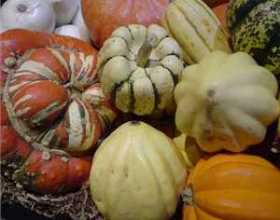How to Grow Squash – A Guide to Growing Squash
 Squash
Squash
There are so many squash varieties, some grow to the size of a small pumpkin and some are the size of cricket balls. Squash need a good summer to fruit well. Some of the new varieties have been bred for the British climate, so may be more successful than the old favourites. They can be started early and moved into larger pots in the greenhouse if the weather is still cold to give you a better chance of a good harvest. Squash need to be planted about 1.2m (4ft) apart on the plot, but are quite happy growing in a large pot, as long as you feed them well.
The ornamental gourds are not edible, they are purely for decoration but are grown in exactly the same way.
Sowing and Growing Squash
- Squash, like pumpkins, need plenty of food, water and summer sunshine.
- Sow seed in pots in April Sow the flat seeds on edge to prevent rotting.
- You can also sow directly into the planting position in May under a cloche.
- Prepare the planting position by digging a hole of about 2 spades width and depth and add well rotted manure or compost and backfill with soil.
- Pot them up into larger pots and keep in the greenhouse if the weather is still cold at planting out time to give you a better chance of a good harvest, or else plant out covered with a cloche until conditions improve.
- Carefully plant out leaving the plant sitting on a slight mound. You may find it useful to sink a pot next to the plant, so that it can be fed and watered directly to the roots. Mark the watering pot with a stick as it is easy to lose under all the foliage.
- Trailing varieties need plenty of space, about 1.2 m (4 feet) between plants. The growth can be trained into a circle to keep them tidy.
- Water well in dry weather and apply a liquid feed like Miracle Grow or a home-made comfrey feed, every week
- Limit the number of squash per plant to a reasonable number by pinching off excess fruits. A yield of six small ones or 3 large ones is about average.
- A barrier under the fruits, such as a piece of wood or an old tile, will prevent them rotting where they touch the soil.
Harvesting Squash
- For winter storing varieties, harvest by cutting the fruit with stalks of at least 5cms (2ins). Place the squash in a sheltered, sunny place to allow the skins to harden.
- Store in a cool place: a slatted shelf is ideal to allow the air to circulate around the fruits, or store in a net bag or even hung up in an old pair of tights.
- If they get too cold they will spoil, and they will rot quickly if stored in too warm a position.
- Storage times vary, but butternut squash should last until February and sometimes longer.
Pests and Problems with Squash
- Slugs are the greatest problem, so use your favourite method of control.
- Rats and mice can sometimes nibble the fruit.
- In late summer the leaves can get mildew, make sure the plants are well watered and remove any infected leaves to reduce further infection.
Varieties of Squash
- There are many varieties to choose from, both very old varieties and modern hybrids, of all shapes and sizes
- The standard butternut squash is a consistent, reliable cropper and has a good flavour. Some of the new varieties are specially bred for British conditions.
- Vegetable spaghetti is popular, flesh forms spaghetti-like strands after cooking
- Custard squashes, aka patty pan squashes, look like scalloped-edged flying saucers and are similar to courgettes in flavour.
Eating Squash
- There are many different ways to use squash, in sweet and savoury dishes.



